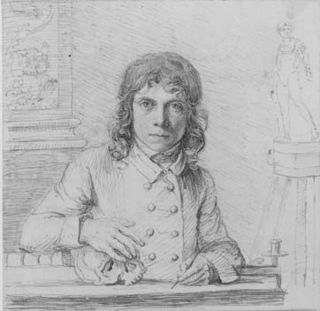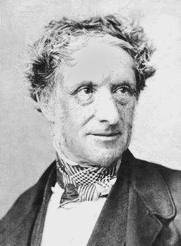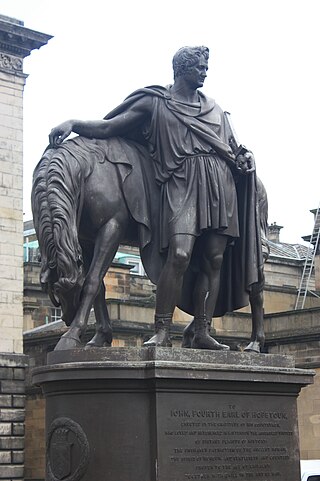
John Bacon was a British sculptor who worked in the late 18th century. Bacon has been reckoned the founder of the British School of sculpture. He won numerous awards, held the esteem of George III, and examples of his works adorn St Paul's Cathedral and Westminster Abbey in London, Christ Church, Oxford, Pembroke College, Oxford, Bath Abbey and Bristol Cathedral.

Edward Hodges Baily was a prolific British sculptor responsible for numerous public monuments, portrait busts, statues and exhibition pieces as well as works in silver. He carved friezes for both the Marble Arch and Buckingham Palace in London. His numerous statues of public figures include that of Horatio Nelson on top of Nelson's Column and Charles Grey, 2nd Earl Grey on Grey's Monument in Newcastle upon Tyne. Throughout his career Baily was responsible for creating a number of monuments and memorials for British churches and cathedrals, including several in St Paul's Cathedral.

Joseph Nollekens R.A. was a sculptor from London generally considered to be the finest British sculptor of the late 18th century.

Giovanni Battista Cipriani was an Italian painter and engraver, who lived in England from 1755. He is also called Giuseppe Cipriani by some authors. Much of his work consisted of designs for prints, many of which were engraved by his friend Francesco Bartolozzi.

John Flaxman was a British sculptor and draughtsman, and a leading figure in British and European Neoclassicism. Early in his career, he worked as a modeller for Josiah Wedgwood's pottery. He spent several years in Rome, where he produced his first book illustrations. He was a prolific maker of funerary monuments.

Sir Francis Leggatt Chantrey was an English sculptor. He became the leading portrait sculptor in Regency era Britain, producing busts and statues of many notable figures of the time. Chantrey's most notable works include the statues of King George IV ; King George III (Guildhall), and George Washington. He also executed four monuments to military heroes for St Paul's Cathedral, London. He left the Chantrey Bequest for the purchase of works of art for the nation, which was available from 1878 after the death of his widow.

Sir Joseph Edgar Boehm, 1st Baronet, was an Austrian-born British medallist and sculptor, best known for the "Jubilee head" of Queen Victoria on coinage, and the statue of the Duke of Wellington at Hyde Park Corner. During his career Boehm maintained a large studio in London and produced a significant volume of public works and private commissions. A speciality of Boehm's was the portrait bust; there are many examples of these in the National Portrait Gallery. He was often commissioned by the Royal Family and members of the aristocracy to make sculptures for their parks and gardens. His works were many, and he exhibited 123 of them at the Royal Academy from 1862 to his death in 1890.

Louis-François Roubiliac was a French sculptor who worked in England. One of the four most prominent sculptors in London working in the rococo style, he was described by Margaret Whinney as "probably the most accomplished sculptor ever to work in England".

Sir Richard Westmacott was a British sculptor.

Matthew Noble was a leading British portrait sculptor. Carver of numerous monumental figures and busts including work, memorializing Victorian era royalty and statesmen, displayed in locations such as Westminster Abbey, St Paul's Cathedral and Parliament Square, London.

Richard Westmacott (the younger) RA (14 April 1799 – 19 April 1872) – also sometimes described as Richard Westmacott III (to distinguish him from his father and grandfather – both sculptors bearing the same name) – was a prominent English sculptor of the early and mid-19th century.
Prince Hoare was an English sculptor. "Prince" in this instance was a given name, not a royal title.
Sir Henry Cheere, 1st Baronet was an English sculptor and monumental mason. He was the older brother of John Cheere, also a notable sculptor.

Laurent Delvaux was a Flemish sculptor. After a successful international career that brought him to London and Rome, he returned to the Austrian Netherlands where he was a sculptor to the court. Delvaux was a transitional figure between the Baroque and Neo-classicism.
John Bacon (1777–1859), also known as John Bacon the Younger, or Junior, to distinguish him from his equally famous father, was an English sculptor.

Samuel Joseph was a British sculptor, working in the early 19th century.

William Tyler was an English sculptor, landscaper, and architect, and one of the three founding members of the Royal Academy, in 1768. He was Director of the Society of Artists.

Thomas Campbell was a Scottish sculptor in the early 19th century. He has several important public works, most notably a statue of Sarah Siddons in Westminster Abbey. He also has several works in the National Gallery in London. He was heavily patronised by the British aristocracy, as evidenced by his works.

In 1757, the actor David Garrick commissioned the sculptor Louis-François Roubiliac to make a full-size marble statue of William Shakespeare for Garrick's octagonal Temple to Shakespeare, erected near his villa beside the River Thames at Hampton, to the west of London. The sculpture cost 300 guineas and was installed at Garrick's temple in 1758; it remained there until it was bequeathed to the British Museum along with Garrick's books in 1779. The sculpture was transferred to the new British Library in 2005, where it is displayed on a new travertine plinth beside the main staircase in the main entrance hall.
Nicholas Read (c.1733–1787) was an 18th-century English sculptor. He was the only apprentice that Roubiliac ever accepted.




















